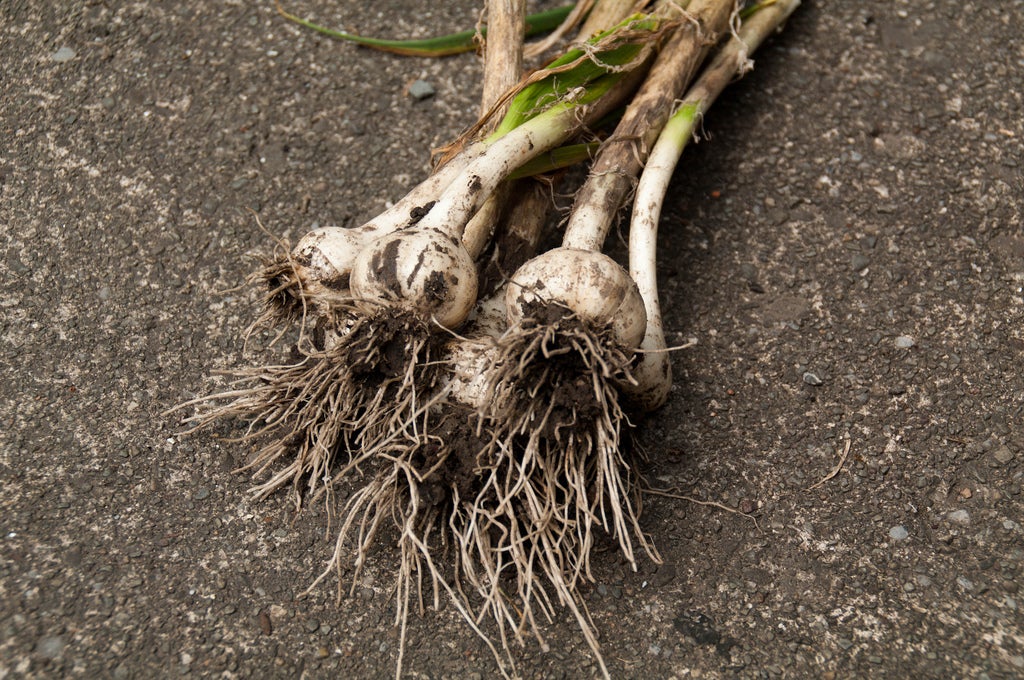German White Garlic Info – How To Grow German White Garlic


What is German White garlic? According to German White garlic information, this is a large, strong-flavored hardneck type garlic. German White garlic is a Porcelain type with satin white bulbs. For information about how to grow German White garlic, read on.
German White Garlic Info
Many gardeners growing German White garlic declare it their favorite. Its claim to fame is the size of its cloves. The big bulbs have only four to six cloves, which makes them easier to peel.
Exactly what is German White garlic? It’s an extremely popular type of hardneck garlic with ivory bulbs. The clove wrappers, however, are pink. This garlic is known by several other names. These include German Extra-Hardy, Northern White and German Stiffneck.
These huge garlic bulbs have a rich, deep flavor with lasting heat. Are they spicy? They are, but not too much, just enough. This garlic softens and sweetens when it is cooked and is excellent in pesto, roasts and sauces.
If you are considering growing German White garlic, you’ll be happy to hear that it stores well for a hardneck. You can leave it in cold storage and it will stay good until March or April.
How to Grow German White Garlic
Growing German white garlic is not very difficult. For a 25-foot (7.6 m.) row, you’ll need a pound of garlic. Crack the bulbs into cloves and plant them 6 inches (15 cm.) apart, ideally in September or October.
Plant the garlic, pointed end up, in full sun in a sandy or loamy soil that offers excellent drainage. Each one should be about 2 to 4 inches (5 to 10 cm.) deep, measuring from the top of the clove. Place mulch on top.
Gardening tips, videos, info and more delivered right to your inbox!
Sign up for the Gardening Know How newsletter today and receive a free copy of our e-book "How to Grow Delicious Tomatoes".
Water the garlic only when the soil is dry. Too much water means that the garlic will rot. Fertilize in the spring with a high nitrogen fertilizer, and keep weeds down.
When the garlic stalks start to form little stems called scapes, prune them off when they curl. This makes sure the energy goes into building large bulbs, rather than producing flowers. Good news, though – garlic scapes are edible too.

Teo Spengler is a master gardener and a docent at the San Francisco Botanical Garden, where she hosts public tours. She has studied horticulture and written about nature, trees, plants, and gardening for more than two decades. Her extended family includes some 30 houseplants and hundreds of outdoor plants, including 250 trees, which are her main passion. Spengler currently splits her life between San Francisco and the French Basque Country, though she was raised in Alaska, giving her experience of gardening in a range of climates.
-
 Creative Ideas For Plant Containers: 7 Ways To Save Money And Add Charm To A Garden
Creative Ideas For Plant Containers: 7 Ways To Save Money And Add Charm To A GardenIf you are looking for great ways to add personality to your container gardening – and even save yourself some money – then try these creative ideas for plant containers
By Mary Ellen Ellis
-
 How To Make A Bouquet Garni Or Herb Bundle For Cooking
How To Make A Bouquet Garni Or Herb Bundle For CookingIf you’re a great cook, you may have made an herb bundle before. If this is a new idea, learn how to add sparkle and interest to your dish with a bouquet garni.
By Amy Grant